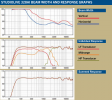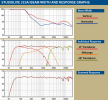Digital_Thor
Senior Member
Have a new idea.... or at least, I think it's new 
Been playing with a KEF coax driver in my DIY active system for a while now. It sits on top of 2 x 8" SB NRX woofers and is integrated with 4 subwoofers scattered around the room.
Not pretty, and I need to design the finished cabinet for either a 2 box or a combined box for the Coax and the woofers.
First question is. Is there a real world benefit to place the woofers top/bottom of the coax - like WCW - instead of leaving them together under the coax like most designs. Floor bounce smoothing?
Second question. Would it be possible to make both woofers cardioid? Benefits seems cool - but I understand the challenges are not easy as a DIY project.
I was thinking of using the new Dayton signature 225, because they look cool and seem to be a lot of value for the price. Also, data suggest that they play in small volumes, reaching 65Hz at -3dB, matching my multi subwoofer system nicely.
Any help is highly appreciated.
Been playing with a KEF coax driver in my DIY active system for a while now. It sits on top of 2 x 8" SB NRX woofers and is integrated with 4 subwoofers scattered around the room.
Not pretty, and I need to design the finished cabinet for either a 2 box or a combined box for the Coax and the woofers.
First question is. Is there a real world benefit to place the woofers top/bottom of the coax - like WCW - instead of leaving them together under the coax like most designs. Floor bounce smoothing?
Second question. Would it be possible to make both woofers cardioid? Benefits seems cool - but I understand the challenges are not easy as a DIY project.
I was thinking of using the new Dayton signature 225, because they look cool and seem to be a lot of value for the price. Also, data suggest that they play in small volumes, reaching 65Hz at -3dB, matching my multi subwoofer system nicely.
Any help is highly appreciated.




